 Get your holidays off to a delectable start this year with bouchées à la reine — literally, mouthfuls for the queen. This supremely French savory starter consists of pastry shells with an elegant filling, for example sea scallops or mushrooms in a creamy sauce. The shells are made using puff pastry, while the sauce is a Béchamel with a dash of white wine. Preparation is a bit of a production, but it’s fun. Then sit back and prepare for applause.
Get your holidays off to a delectable start this year with bouchées à la reine — literally, mouthfuls for the queen. This supremely French savory starter consists of pastry shells with an elegant filling, for example sea scallops or mushrooms in a creamy sauce. The shells are made using puff pastry, while the sauce is a Béchamel with a dash of white wine. Preparation is a bit of a production, but it’s fun. Then sit back and prepare for applause.
Bouchées à la reine / Elegant filled pastry shells
Bouchées à la reine were a dime a dozen when I first got to Paris. You could find them in pastry shops and delis (charcuteries), filled with morsels of chicken, ham, mushrooms, fish dumplings (quenelles) or, often, sweetbreads (ris de veau). People would take them home and heat them up in the oven, for lunch or as the starter of a more elaborate meal.
 But culinary fashions evolve and these days bouchées are seen less often, so I decided to try my hand at home. Making the shells is like playing with Play-Doh. You cut out large rounds of pastry, rings of the same size and smaller rounds for the caps. You top the large rounds with the rings and set the small rounds beside them, coat everything with an egg wash and pop them into the oven. You then make the filling and assemble the pastries.
But culinary fashions evolve and these days bouchées are seen less often, so I decided to try my hand at home. Making the shells is like playing with Play-Doh. You cut out large rounds of pastry, rings of the same size and smaller rounds for the caps. You top the large rounds with the rings and set the small rounds beside them, coat everything with an egg wash and pop them into the oven. You then make the filling and assemble the pastries.
Perhaps unsurprisingly in France, there’s a story of passion behind the invention of bouchées à la reine. This dates back to the 18th century, when the Polish-born wife of Louis XV, Queen Marie Leszczynska, was seeking a way to one-up her rival, Madame de Pompadour, the king’s mistress. The queen allegedly asked her pastry chef to create a savory dish with aphrodisiac qualities — a dish more refined than the sweet pastries created by the chef of Madame de Pompadour.
 I’ve never found bouchées a la reine to be of a particularly aphrodisiac nature, but who knows? Maybe with enough Champagne… Today’s recipe includes the sea scallop and the mushroom versions. You can make one or the other, or both.
I’ve never found bouchées a la reine to be of a particularly aphrodisiac nature, but who knows? Maybe with enough Champagne… Today’s recipe includes the sea scallop and the mushroom versions. You can make one or the other, or both.
Happy holidays, and happy cooking!
The Everyday French Chef will be on vacation until the New Year. For holiday menu ideas, click here.
 The recipe booklet on offer for readers of my novel, The Rites of Man, is now available. To receive it, send a photo of yourself with the book to megbortin@everydayfrenchchef.com.
The recipe booklet on offer for readers of my novel, The Rites of Man, is now available. To receive it, send a photo of yourself with the book to megbortin@everydayfrenchchef.com.

 This is a special edition of The Everyday French Chef to tell you what I’ve been cooking up outside of the kitchen. Not to worry, recipes will resume next week, with an elegant starter to serve over the holidays. But this week the big news is the publication of my first novel, The Rites of Man, with a special offer for readers of this website. I’ve prepared a recipe booklet featuring dishes mentioned in my novel that I’ll send you in exchange for a photo of you with my book. I’ve already posted about this here and on Facebook, and the first photo is already in! It’s from Martha Huang, who’s currently visiting Shanghai.
This is a special edition of The Everyday French Chef to tell you what I’ve been cooking up outside of the kitchen. Not to worry, recipes will resume next week, with an elegant starter to serve over the holidays. But this week the big news is the publication of my first novel, The Rites of Man, with a special offer for readers of this website. I’ve prepared a recipe booklet featuring dishes mentioned in my novel that I’ll send you in exchange for a photo of you with my book. I’ve already posted about this here and on Facebook, and the first photo is already in! It’s from Martha Huang, who’s currently visiting Shanghai. Instead of sending a selfie, Martha provided this view of, as she put it, ‘the far-flung reaches of The Rites of Man‘, with the Shanghai skyline in the background. I’m pretty excited about that! She had pre-ordered the book, so it arrived on publication day, which was Wednesday. She wrote to me on Thursday: ‘Hello hello from Shanghai — just to say your book arrived on my Kindle yesterday as promised and have inhaled it — thank you for a marvelous read.’ I’m even more excited about that!
Instead of sending a selfie, Martha provided this view of, as she put it, ‘the far-flung reaches of The Rites of Man‘, with the Shanghai skyline in the background. I’m pretty excited about that! She had pre-ordered the book, so it arrived on publication day, which was Wednesday. She wrote to me on Thursday: ‘Hello hello from Shanghai — just to say your book arrived on my Kindle yesterday as promised and have inhaled it — thank you for a marvelous read.’ I’m even more excited about that! Sichuan-style sesame noodles are very popular in Paris, but they’re not exactly French. So why am I featuring them in today’s post? Because sesame noodles are among the dishes mentioned in my forthcoming novel,
Sichuan-style sesame noodles are very popular in Paris, but they’re not exactly French. So why am I featuring them in today’s post? Because sesame noodles are among the dishes mentioned in my forthcoming novel, 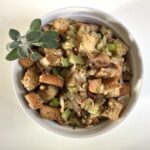 Just in time for Thanksgiving in the United States, here’s a chestnut stuffing recipe with a French twist. Herbes de Provence and, especially, fresh sage impart an unbeatable flavor that will have your guests clamoring for more. The stuffing may be prepared in less than an hour and — here’s the beauty of it — can be made ahead of time and frozen until the big day. Then all you have to do is set the table and stuff the turkey.
Just in time for Thanksgiving in the United States, here’s a chestnut stuffing recipe with a French twist. Herbes de Provence and, especially, fresh sage impart an unbeatable flavor that will have your guests clamoring for more. The stuffing may be prepared in less than an hour and — here’s the beauty of it — can be made ahead of time and frozen until the big day. Then all you have to do is set the table and stuff the turkey. The Arte team took an early morning train down to Vonnas, the site of Georges Blanc’s best-known restaurants. My job was to bring the cranberry sauce — and then to pose for the recreation of the Rockwell scene. (That’s me with Georges Blanc at right). His take on Thanksgiving featured roasted figs, the pumpkin gratin and the smallest turkey I’d ever seen. I wrote about this experience at the time, so if you like you can read more
The Arte team took an early morning train down to Vonnas, the site of Georges Blanc’s best-known restaurants. My job was to bring the cranberry sauce — and then to pose for the recreation of the Rockwell scene. (That’s me with Georges Blanc at right). His take on Thanksgiving featured roasted figs, the pumpkin gratin and the smallest turkey I’d ever seen. I wrote about this experience at the time, so if you like you can read more  French fish soup is a deeply flavorful dish that is traditionally served with rounds of toast, grated cheese and rouille, a garlic mayonnaise flavored with saffron and cayenne. Unlike other fish soups, this one comes to the table totally smooth, without any pieces of fish. In the classic version, fresh fish are cooked, bones and all, with veggies and herbs, and the soup is passed through a sieve. One can simplify by using fish fillets, fresh or frozen.
French fish soup is a deeply flavorful dish that is traditionally served with rounds of toast, grated cheese and rouille, a garlic mayonnaise flavored with saffron and cayenne. Unlike other fish soups, this one comes to the table totally smooth, without any pieces of fish. In the classic version, fresh fish are cooked, bones and all, with veggies and herbs, and the soup is passed through a sieve. One can simplify by using fish fillets, fresh or frozen.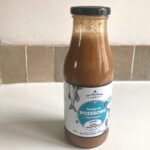 The color of French fish soup can vary from salmon pink to rusty red, most likely a result of the type and amount of tomatoes used. Mine came out pink, probably because it’s autumn and fresh tomatoes are less red and ripe than in mid-summer. The soup may also be made with tinned tomatoes.
The color of French fish soup can vary from salmon pink to rusty red, most likely a result of the type and amount of tomatoes used. Mine came out pink, probably because it’s autumn and fresh tomatoes are less red and ripe than in mid-summer. The soup may also be made with tinned tomatoes. This sophisticated French take on the burger is made of ground veal flavored with grated Comté cheese, garlic and herbs, then lightly breaded and fried. Serve it on a bun, and it becomes child friendly. But it also makes a surprisingly elegant main dish that marries well with anything from pasta to veggies to salad. And despite its name, which makes it sound like an Italian dish from Milan, this dish is totally French — and rather unusual.
This sophisticated French take on the burger is made of ground veal flavored with grated Comté cheese, garlic and herbs, then lightly breaded and fried. Serve it on a bun, and it becomes child friendly. But it also makes a surprisingly elegant main dish that marries well with anything from pasta to veggies to salad. And despite its name, which makes it sound like an Italian dish from Milan, this dish is totally French — and rather unusual. It’s the tail end of summer, so let’s make pickles! Not the tiny, vinegary French kind, but home-style dill pickles with an East European flavor. I am dedicating this post to my Ukrainian friend Valya, who returned to Kyiv this week after three-and-a-half years as a war refugee in Paris. It’s as dangerous there as ever, but for her it was just time to go home. I made these pickles for her as part of the picnic I gave her for her two-day bus journey back.
It’s the tail end of summer, so let’s make pickles! Not the tiny, vinegary French kind, but home-style dill pickles with an East European flavor. I am dedicating this post to my Ukrainian friend Valya, who returned to Kyiv this week after three-and-a-half years as a war refugee in Paris. It’s as dangerous there as ever, but for her it was just time to go home. I made these pickles for her as part of the picnic I gave her for her two-day bus journey back. Four hours later you can already try your pickles! They’ll be crunchy, with plenty of flavor. If you’d rather save them for later, you can transfer them to a clean jar and refrigerate for up to a week — no sterilization needed. It’s also possible to preserve the pickles by canning, but this is a far more complicated procedure. Many sites online explain how to do it, if you’re interested.
Four hours later you can already try your pickles! They’ll be crunchy, with plenty of flavor. If you’d rather save them for later, you can transfer them to a clean jar and refrigerate for up to a week — no sterilization needed. It’s also possible to preserve the pickles by canning, but this is a far more complicated procedure. Many sites online explain how to do it, if you’re interested. An artist, she went out every day to draw and paint Paris. Here is one of her works. It shows Marianne, the symbol of the French republic, draped in a Ukrainian flag. Valya made the sketch at the Place de la République shortly after a pro-Ukraine demonstration when people still thought the war would be brief. She gave it to me for my birthday three years ago. And the war goes on…
An artist, she went out every day to draw and paint Paris. Here is one of her works. It shows Marianne, the symbol of the French republic, draped in a Ukrainian flag. Valya made the sketch at the Place de la République shortly after a pro-Ukraine demonstration when people still thought the war would be brief. She gave it to me for my birthday three years ago. And the war goes on…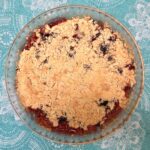 It’s blackberry season and, when down in Provence last week, I couldn’t resist the temptation to make a blackberry-nectarine crumble. The two fruits married beautifully. Blackberries on their own would have been difficult because Provence got hammered by extreme heat and dry weather this summer. The blackberries on the bushes lining the road near my friends’ place were less plump and juicy than usual, and fewer and farther between.
It’s blackberry season and, when down in Provence last week, I couldn’t resist the temptation to make a blackberry-nectarine crumble. The two fruits married beautifully. Blackberries on their own would have been difficult because Provence got hammered by extreme heat and dry weather this summer. The blackberries on the bushes lining the road near my friends’ place were less plump and juicy than usual, and fewer and farther between.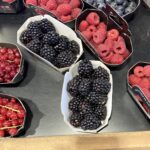 So now let’s leave this thorny subject (pun intended, sorry) and return to our two-fruit crumble. To tell you the truth, I cheated a little by adding some store-bought blackberries, which are far larger than the fruit one finds growing wild and therefore suspect, in my view. However, in this case it made for a juicier crumble. You can improvise, too — with peaches instead of nectarines, or blueberries instead of the mûres, or whatever strikes your fancy.
So now let’s leave this thorny subject (pun intended, sorry) and return to our two-fruit crumble. To tell you the truth, I cheated a little by adding some store-bought blackberries, which are far larger than the fruit one finds growing wild and therefore suspect, in my view. However, in this case it made for a juicier crumble. You can improvise, too — with peaches instead of nectarines, or blueberries instead of the mûres, or whatever strikes your fancy.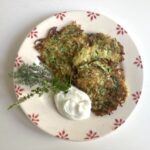 Move over, potato pancakes. This lighter, summery version with zucchini is perfect in hot weather. The pancakes combine grated zucchini and potato with egg and plenty of herbs — mint is my favorite. Fried in olive oil until crispy and golden, they may be served on their own or with a tangy yogurt-garlic sauce. You can make them in half an hour for a couple of people. Or, if serving for a crowd, make a lot — you’ll find them going like pancakes…
Move over, potato pancakes. This lighter, summery version with zucchini is perfect in hot weather. The pancakes combine grated zucchini and potato with egg and plenty of herbs — mint is my favorite. Fried in olive oil until crispy and golden, they may be served on their own or with a tangy yogurt-garlic sauce. You can make them in half an hour for a couple of people. Or, if serving for a crowd, make a lot — you’ll find them going like pancakes…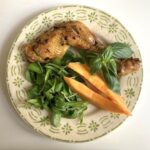 Grilled chicken with rosemary and thyme is one of the delights of the summer season, particularly if you have access to a barbecue — but even if you don’t, as I experienced once again last weekend while staying at a friend’s place in Normandy. We marinated the chicken in olive oil, lemon juice, minced garlic and the herbs, fresh from her garden. We had planned a barbecue, but alas the heavens opened. So we grilled it in the oven. Ab fab…
Grilled chicken with rosemary and thyme is one of the delights of the summer season, particularly if you have access to a barbecue — but even if you don’t, as I experienced once again last weekend while staying at a friend’s place in Normandy. We marinated the chicken in olive oil, lemon juice, minced garlic and the herbs, fresh from her garden. We had planned a barbecue, but alas the heavens opened. So we grilled it in the oven. Ab fab…

